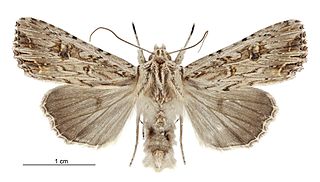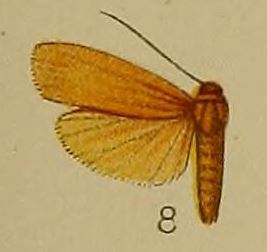
The large tortoiseshell or blackleg tortoiseshell is a butterfly of the family Nymphalidae.

Cerapteryx graminis, the antler moth, is a moth of the family Noctuidae. It is a common species throughout most of Europe but is lacking in the very dry southern regions. The northernmost occurrence is Iceland, and above the Arctic circle. It also occurs in Siberia and in North Mongolia. The species has been introduced to North America. In the Alps it rises to an altitude of 2100 meters.

Papilio clytia, the common mime, is a swallowtail butterfly found in south and southeast Asia. The butterfly belongs to the subgenus Chilasa, the black-bodied swallowtails. It serves as an excellent example of a Batesian mimic among the Indian butterflies.

The purple-shot copper is a butterfly in the family of the Lycaenidae or copper butterflies and in the genus of the Lycaena.

Lampides boeticus, the pea blue, or long-tailed blue, is a small butterfly that belongs to the lycaenids or gossamer-winged family.

Apatura ilia, the lesser purple emperor, is a species of butterfly native to most of Europe and east across the Palearctic. It is named for its similarity to the purple emperor butterfly.

Melanitis phedima, the dark evening brown, is a species of butterfly found flying at dusk. The flight of this species is erratic. They are found in south and southeast Asia.

Hipparchia hermione, the rock grayling, is a butterfly of the family Nymphalidae. The species can be found in Central Europe, Southern Europe, Eastern Europe, North Africa, Anatolia and the Caucasus.

Melitaea didyma, the spotted fritillary or red-band fritillary, is a Palearctic butterfly of the family Nymphalidae.

Calliteara pudibunda, the pale tussock, is a moth of the family Erebidae. The Dutch common name for the moth (Meriansborstel) comes from the butterfly and insect painter Maria Sibylla Merian. The species was first described by Carl Linnaeus in his 1758 10th edition of Systema Naturae. It is found in Asia and Europe.

Platyja is a genus of moths of the family Erebidae erected by Jacob Hübner in 1823.

Ichneutica lignana is a moth of the family Noctuidae. It is endemic to New Zealand. This species is found on the Three Kings Islands as well as the North, South and Stewart Islands. This species lives in a variety of habitats including coastal areas, tussock grasslands, shrublands, and native forest, at a range of altitudes from sea level to over 1300 m. I. lignana is quite distinctive in appearance with its dark markings on the abdomen and forewings although it is possible to confuse Ichneutica morosa, Meterana pansicolor and Meterana pascoi with this species. Adults are on the wing throughout the year in the northern parts of the New Zealand but are restricted to the months of October to April in the more southern parts of the country.

Stauropus alternus, the lobster caterpillar, lobster moth or crab caterpillar, is a moth of the family Notodontidae. It is found in the north-eastern Himalaya, Sri Lanka, Sundaland, the Philippines, Sulawesi and the southern Moluccas. It was described by Francis Walker in 1855.

Mesotype didymata, the twin-spot carpet, is a moth of the family Geometridae. The species was first described by Carl Linnaeus in his 1758 10th edition of Systema Naturae. Its genus is sometimes included in Perizoma.
Meganola brunellus is a moth of the family Nolidae. It is found in Sri Lanka, India, Taiwan, Japan, the Ryukyu Islands, Sundaland, Queensland and the Bismarck Islands. It is an introduced species in Hawaii.

Brunia antica is a moth of the family Erebidae described by Francis Walker in 1854. It is found from the Indian subregion, Sri Lanka to China, the Ryukyu Islands, the Chagos Archipelago, the Nicobar Islands and Sundaland.

Papilio androgeus, the Androgeus swallowtail, queen page, or queen swallowtail, is a Neotropical butterfly of the family Papilionidae. It is found from Mexico to Argentina with a small population in southern Florida.

Gesonia obeditalis is a species of moth of the family Noctuidae first described by Francis Walker in 1859. It is found from eastern Africa, the Seychelles, the Maldives and the Oriental tropics of India, Myanmar, Sri Lanka east to the Philippines, the Sula Islands and Australia. The adult moth has brown wings with a scalloped dark brown band near the margin. The hindwings are similar in pattern to the forewings but are a paler shade of brown.

Polyommatus golgus, the Sierra Nevada blue, is a species of butterfly in the family Lycaenidae. It is endemic to Spain with habitat in the Sierra Nevada in Andalusia, and is an endangered species.

Charaxes affinis is a butterfly in the family Nymphalidae. It was described by Arthur Gardiner Butler in 1866. It is found in the Indomalayan realm.



















